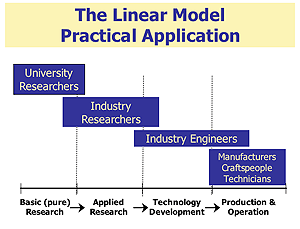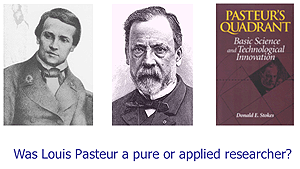|
|
And somebody will say “semiconductors.” They go, where were those first three guys? Where did they work? At the Bell Telephone laboratories. Okay? So it doesn't have to be university. Anyway, the singular view of this is university researchers with a significant overlap in this transition zone, industry researchers go on to industry engineers, to manufacturers, craftspeople and technicians who are actually developing products. So you can from the basic pure research, applied research, to technology development and finally out into real products that go out into the world.
Is this real? No, it's not real at all. Is it historically based? Some of the justification of Vannevar Bush of this view of the world dated back to the Greeks and the concept for pure knowledge, the concept of isolation, Plato’s idea of the separation of the intellectual from society in order to have the pure, curiosity-driven thinking process subjected to pure reason and reason alone.
When Louis Pasteur was about 22, 23 years old in Paris, he was a 100-percent curiosity-driven researcher who looked at racemic acids, actually chirality [from the Greek, “handedness,” a property of some molecules to be “left-handed” or “right-handed”]. He showed one of the earliest principles that molecules can have precisely the same chemical composition, exactly the same molecular weight, exactly the same size, exactly the same constituents, but if one is left-handed and the other is right-handed, the way in which they interact with light can polarize light one direction versus another direction. He showed that this was not a funny phenomenon but, rather, a super imposable phenomenon, and so you could actually get material, and racemic acid was the example, where you could have equal left and equal right, so it looks like it didn't polarize light at all, but if you separated out the left-handed stuff and the right-handed stuff, you could have one going one way and one going the other way, one of the most fundamental discoveries in science.
>
01 02 03 04 05 06 07 08 09 10 11 12 13 14 15 16 17 18 19
|
|


|
